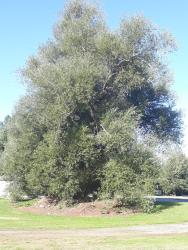Erect trees with a single trunk. Terminal branchlets erect or pendulous. Stipules small or very small and usually deciduous. Leaves alternate. Spherical glands often present at the distal end of the petiole where it meets the lamina. Mature leaves narrowly to very narrowly ovate (length to width ratio 4–13:1 except, in New Zealand, Salix pentandra and its hybrid S. ×meyeriana, 1.3–3.6:1), margins serrulate, plane, not revolute nor undulate, hairs on emerging leaves sparse to dense, usually deciduous, hairs on mature leaves absent or confined to the midvein (but moderately dense in S. alba). Willow sawfly galls commonly present. Catkin emergence commonly coetaneous with leaf emergence but may be precocious or serotinous. Flower bracts usually deciduous, hyaline-green, narrowly ovate, channelled and concave at base. Male flowers with 2, rarely 4, nectaries. Female flowers with 1 or 2 nectaries. Male flowers with 2–6 stamens, filaments free or (in hybrids) fused only at the base, usually villous hairs present at the filament base. Anthers usually yellow before opening. Ovary usually glabrous, sessile or on a short stipe ca. 0.5 mm long, tapering to a short style or directly to the style arms, style arms unlobed or lobed, hyaline, pale green, or pale yellow-green.
| 1 | Mature leaf lamina completely glabrous; stamens of male catkins 3–6 | 2 |
| Mature leaf lamina with some hairs (may be confined to the midvein and petiole); stamens of male catkins 2 | 6 | |
| 2 | Leaves 9–29 mm wide, length to width ratio 4–13:1, not glaucous below, thin in texture; stamens 4 or 6 | 3 |
| Leaves 26–79 mm wide, ovate to very narrowly oblong-ovate, length to width ratio 1.3–5.0:1, lower leaf surface glaucous or not, leaves thick in texture; stamens 3–6 | 5 | |
| 3 | Leaves 9–13 mm wide, leaf galls sometimes present; stamens usually 5; flower bract distinctly toothed at the apex | humboldtiana |
| Leaves 9–29 mm wide, leaf galls absent; stamens 4 or 6; flower bract entire or indistinctly toothed at the apex | 4 | |
| 4 | Leaves 9–29 mm wide; emerging leaves glabrous; male and female plants present in New Zealand; male catkins 52–57 mm long; stamens 6 | nigra |
| Leaves 20–28 mm wide; emerging leaves tomentose; male plants only present in New Zealand; catkins 33–64 mm long; stamens 4 | gooddingii | |
| 5 | Leaves 41–79 mm wide, ovate, not glaucous below; stamens 5; glandular teeth extending from leaf margin onto petiole as clusters of glands | pentandra |
| Leaves 26–34 mm wide, very narrowly oblong-ovate, glaucous below; stamens 3–6; glands on leaf margin teeth inconspicuous and not extending onto petiole | lasiandra | |
| 6 | Terminal branchlets long and pendent (terminal branchlet ca. 1 m long) | 7 |
| Terminal branchlets not long-pendent (branchlets may be pendent but terminal unbranched segment is short, ca. 30 cm long) | 8 | |
| 7 | Year-old branchlets golden; catkins with both sexes and teratological flowers present; stomata dense on upper leaf surface | ×pendulina f. salamonii |
| Year-old branchlets grey-brown; female plants only in New Zealand; stomata dense all over the upper leaf surface, only near the midvein, or absent | ×pendulina f. pendulina | |
| 8 | Stomata on upper leaf surface dense; branches and leaves sometimes twisted; female flower bracts persist after flowering | 9 |
| Stomata on upper leaf surface sparse; branches and leaves never twisted; female flower bracts deciduous | 10 | |
| 9 | Branchlets sinuous, leaves concave in the lower ⅔, twisted; commonly female plants, male plants rare in New Zealand; leaf galls absent | matsudana ‘Tortuosa’ |
| Branchlets straight, leaves plane and not twisted; both sexes equally present in New Zealand; leaf galls sometimes present | matsudana | |
| 10 | Female bracts persistent; stamen filaments variably united in the same catkin (united at base only to near the anthers) | matsudana × alba |
| Female bracts deciduous; stamen filaments free | 11 | |
| 11 | Young leaves densely long-silky hairy on both surfaces, hairs persisting to some degree on the lower surface; leaf galls common and abundant | alba |
| Young leaves sparsely long-silky hairy on lower surface, sometimes both surfaces, usually becoming glabrous except for the lower surface midvein (rarely in S. ×fragilis f. vitellina dense on lower surface of mature leaves); leaf galls rare to ubiquitous | 12 | |
| 12 | Trees often flat-topped; branchlets olive-green to olive-brown; most commonly male in New Zealand; male flower bracts 1.7–2.3 mm long; leaf galls ubiquitous and dense | fragilis f. fragilis |
| Trees round-topped; branchlets yellow, orange, or orange-red; exclusively female in New Zealand; female flower bracts 3.0–4.0 mm long; leaf galls rare | fragilis f. vitellina |
Wu et al. (2015) reported that the subgenus has 128 species, 109 species native to the Old World.
| Category | Number |
|---|---|
| Exotic: Fully Naturalised | 4 |
| Exotic: Casual | 2 |
| Exotic: Cultivated | 3 |
| Total | 9 |
Subgenus Salix is monophyletic if minor elements are removed (Wu et al. 2015). Two defining features of the subgenera, number of stamens (many versus two), and free versus connate bud-scale margins have changed state repeatedly and are not a good basis for further division as traditionally believed.
The commonest tree willows have an order of flowering in springtime that is helpful for identification: Salix matsudana × S. alba (starting in early August), S. ×pendulina f. pendulina, S. ×pendulina f. salamonii, S. matsudana 'Tortuosa', S. ×fragilis f. fragilis, S. ×fragilis f. vitellina (starting in early October), S. alba.




